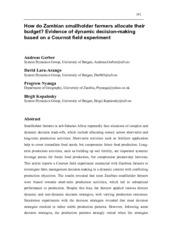How do Zambian smallholder farmers allocate their budget? Evidence of dynamic decision-making based on a Cournot field experiment
Conference lecture
Accepted version
Permanent lenke
https://hdl.handle.net/1956/16971Utgivelsesdato
2017Metadata
Vis full innførselSamlinger
- Department of Geography [634]
Sammendrag
Smallholder farmers in sub-Saharan Africa repeatedly face situations of complex and dynamic decision trade-offs, which include allocating money across short-term and long-term production activities. Short-term activities such as fertilizer application help to cover immediate food needs, but compromise future food production. Long- term production activities, such as building up soil fertility, are important systemic leverage points for future food production, but compromise present-day harvests. This article reports a Cournot field experiment conducted with Zambian farmers to investigate farm management decision-making in a dynamic context with conflicting production objectives. The results revealed that most Zambian smallholder farmers were biased towards short-term production activities, which led to suboptimal performance in production. Despite this bias, the farmers applied various distinct dynamic and non-dynamic decision strategies, with varying production outcomes. Simulation experiments with the decision strategies revealed that most decision strategies resulted in rather stable production patterns. However, following some decision strategies, the production patterns strongly varied when the strategies interacted with other strategies in the same market and the produce was therefore subject to the strategies’ endogenous interactions within the market. Given the farmers’ strong preference for fertilizer, the findings suggest that a shift towards favoring long-term oriented production activities is required to increase food production sustainably in sub-Saharan Africa. In conclusion, the various decision strategies and their endogenous interactions reinforce the need for building adaptive capacity among smallholder farmers in order to apply context-specific decision strategies.
Beskrivelse
Article accepted for the 35th International Conference of the System Dynamics Society, 16–20 July, 2017, Cambridge, MA, USA.
